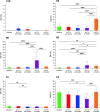The formation of cariogenic plaque to contemporary adhesive restorative materials: an in vitro study
- PMID: 38502470
- PMCID: PMC11415411
- DOI: 10.1007/s10266-024-00913-5
The formation of cariogenic plaque to contemporary adhesive restorative materials: an in vitro study
Abstract
The research exploiting the ability of dental materials to induce or prevent secondary caries (SC) development still seems inconclusive. Controlling bacterial adhesion by releasing bacteriostatic ions and improving the surface structure has been suggested to reduce the occurrence of SC. This paper analyses the impact of five distinctively composed dental materials on cariogenic biofilm formation. Forty-five specimens of three composites (CeramX Spectra ST, Admira Fusion, Beautifil II) and two glass-ionomers (Fuji II LC, Caredyne Restore), respectively, were incubated in bacterial suspension composed of Streptococcus mutans, Lactobacillus acidophilus, Streptococcus mitis, Streptococcus sanguinis, and Streptococcus salivarius at pH 7.0 and 5.5. Coverslips were used as a control. Adhered bacteria were collected after 2, 4, 6, 12, 24, and 48 h and analyzed using quantitative polymerase chain reaction (qPCR). Fluoride leakage was measured at each collection. The specimens' surface topography was assessed using interferometry. In the present study, surface roughness seemed to have a partial role in bacterial adhesion and biofilm formation, together with chemical composition of the materials tested. Despite differences in fluoride leakage, biofilm accumulation was similar across materials, but the number of adhered bacteria differed significantly. A release of other ions may also affect adhesion. These variations suggest that certain materials may be more prone to initiating secondary caries.
Keywords: Biofilm; Caries prevention; Dental materials; Fluoride; Ions.
© 2024. The Author(s).
Conflict of interest statement
None of the authors have any conflict of interest.
Figures





Similar articles
-
Biofilm-induced changes to the composite surface.J Dent. 2017 Aug;63:36-43. doi: 10.1016/j.jdent.2017.05.015. Epub 2017 May 26. J Dent. 2017. PMID: 28554609
-
Biofilm formation and release of fluoride from dental restorative materials in relation to their surface properties.J Dent. 2017 May;60:14-24. doi: 10.1016/j.jdent.2017.02.005. Epub 2017 Feb 14. J Dent. 2017. PMID: 28212980
-
Effect of fluoride-releasing restorative materials on bacteria-induced pH fall at the bacteria-material interface: an in vitro model study.J Dent. 2014 Jan;42(1):15-20. doi: 10.1016/j.jdent.2013.11.006. Epub 2013 Nov 15. J Dent. 2014. PMID: 24246685
-
Review on fluoride-releasing restorative materials--fluoride release and uptake characteristics, antibacterial activity and influence on caries formation.Dent Mater. 2007 Mar;23(3):343-62. doi: 10.1016/j.dental.2006.01.022. Epub 2006 Apr 17. Dent Mater. 2007. PMID: 16616773 Review.
-
Surface properties of resin-based composite materials and biofilm formation: A review of the current literature.Am J Dent. 2015 Dec;28(6):311-20. Am J Dent. 2015. PMID: 26846036 Review.
References
-
- Nedeljkovic I, Teughels W, De Munck J, Van Meerbeek B, Van Landuyt KL. Is secondary caries with composites a material-based problem? Dent Mater. 2015;31(11):e247–77. - PubMed
-
- Bernardo M, Luis H, Martin MD, Leroux BG, Rue T, Leitao J, et al. Survival and reasons for failure of amalgam versus composite posterior restorations placed in a randomized clinical trial. J Am Dent Assoc. 2007;138(6):775–83. - PubMed
-
- Rho YJ, Namgung C, Jin BH, Lim BS, Cho BH. Longevity of direct restorations in stress-bearing posterior cavities: a retrospective study. Oper Dent. 2013;38(6):572–82. - PubMed
-
- Van Nieuwenhuysen JP, D’Hoore W, Carvalho J, Qvist V. Long-term evaluation of extensive restorations in permanent teeth. J Dent. 2003;31(6):395–405. - PubMed
-
- Mjor IA, Dahl JE, Moorhead JE. Age of restorations at replacement in permanent teeth in general dental practice. Acta Odontol Scand. 2000;58(3):97–101. - PubMed
MeSH terms
Substances
LinkOut - more resources
Full Text Sources
Medical
Molecular Biology Databases

